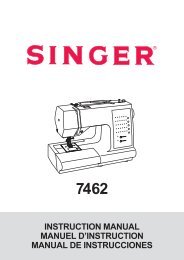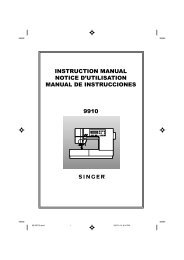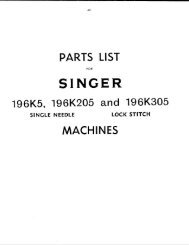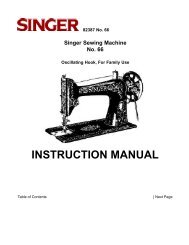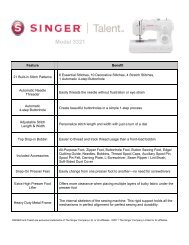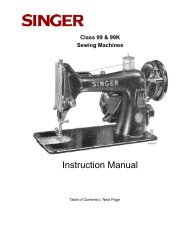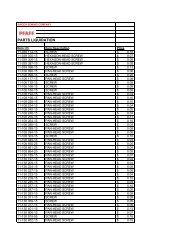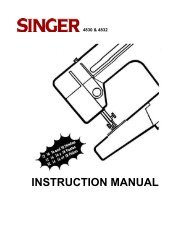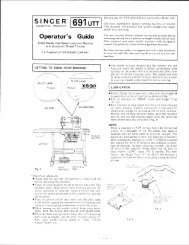Instruction Book Libro de Instrucciones Livret d'Instructions ... - Singer
Instruction Book Libro de Instrucciones Livret d'Instructions ... - Singer
Instruction Book Libro de Instrucciones Livret d'Instructions ... - Singer
Create successful ePaper yourself
Turn your PDF publications into a flip-book with our unique Google optimized e-Paper software.
Zig-zag stitch<br />
The Zig-Zag Stitch can be used when sewing<br />
seams, appliqueing, monogramming or for<br />
<strong>de</strong>corative sewing.<br />
Recommen<strong>de</strong>d Settings<br />
Stitch Selection: Zig-zag stitch (B)<br />
Needle Position:<br />
Stitch Width:<br />
Stitch Length: 2-5<br />
Foot: Special Purpose (B)<br />
Needle Plate: General Purpose (A)<br />
Seam finishing<br />
Use a zig-zag stitch to finish seam edges of<br />
fabrics that are likely to fray.<br />
Sew seams as <strong>de</strong>sired; trim and press open.<br />
Place edge of seam allowance un<strong>de</strong>r foot, as<br />
shown.<br />
Stitch close to edge, letting outer zig-zag fall<br />
over edge fabric.<br />
Satin stitching<br />
Recommen<strong>de</strong>d Settings<br />
Stitch Selection: Zig-zag stitch (B)<br />
Needle Position:<br />
Stitch Width:<br />
12 3 4 5<br />
12 3 4 5<br />
Stitch Length: 0-2<br />
Foot: Special Purpose (J)<br />
Needle Plate: General Purpose (A)<br />
Satin stitching is a series of closely spaced zigzag<br />
stitches. Satin stitch can be used for<br />
monograms, embroi<strong>de</strong>ry and applique work to<br />
produce a smooth satin-like finish.<br />
Practice to get <strong>de</strong>sired stitch appearance.<br />
Block monogramming<br />
Lightly trace letters on right si<strong>de</strong> of fabric.<br />
Centre tracing un<strong>de</strong>r needle.<br />
Stitch entire outline, leaving needle in fabric<br />
when turning.<br />
Pull threads to wrong si<strong>de</strong> of fabric, tie and<br />
trim.<br />
Punto zig-zag<br />
El punto <strong>de</strong> zig-zag se utiliza para coser ribetes,<br />
apliques, monogramas o realizar puntos<br />
<strong>de</strong>corativos.<br />
Positiones recomendadas<br />
Selección punto: Zig-zag (B)<br />
Posición aguja:<br />
Anchura punto:<br />
Longitud punto: 2-5<br />
Prensatelas: Uso general (B)<br />
Plancha aguja: Uso general (A)<br />
Acabado <strong>de</strong> ribetes<br />
Utilice el punto zig-zag para rematar bor<strong>de</strong>s o<br />
ribetes <strong>de</strong> tejidos que son propios a <strong>de</strong>shilarse.<br />
Cosa los ribetes como precise; recórtelos y<br />
planche.<br />
Coloque el bor<strong>de</strong> <strong>de</strong>l ribete <strong>de</strong>bajo <strong>de</strong>l<br />
prensatelas, como se muestra.<br />
Cosa junto al bor<strong>de</strong>, <strong>de</strong>jando que la parte<br />
externa <strong>de</strong>l zig-zag caiga sobre el bor<strong>de</strong>.<br />
Punto <strong>de</strong> realce<br />
Positiones recomendadas<br />
Selección punto: Zig-zag (B)<br />
Posición aguja:<br />
Anchura punto:<br />
12 3 4 5<br />
12 3 4 5<br />
Longitud punto: 0-2<br />
Prensatelas: Uso especial (J)<br />
Plancha aguja: Uso general (A)<br />
El punto <strong>de</strong> realce es una serie <strong>de</strong> puntadas en<br />
zig-zag bastante juntas. Se utiliza para<br />
monogramas, bordado y apliques,<br />
produciendo un acabado suave como <strong>de</strong> satin.<br />
Practique, para conseguir la apariencia<br />
<strong>de</strong>seada <strong>de</strong>l punto.<br />
Monograma en bloque<br />
Marque las letras ligeramente en el anverso<br />
<strong>de</strong>l tejido.<br />
Centre las marcas <strong>de</strong>bajo <strong>de</strong> la aguja.<br />
Cosa todo el contorno, <strong>de</strong>jando la aguja en el<br />
tejido al girar.<br />
Lleve los hilos hacia la parte posterior <strong>de</strong>l<br />
tejido, anú<strong>de</strong>los y córtelos.<br />
Point zig-zag<br />
Ce point peut être utilisé pour surfiler, appliquer,<br />
bro<strong>de</strong>r <strong>de</strong>s monogrammes et autres<br />
décorations.<br />
Réglages recommandés<br />
Sélection <strong>de</strong> point: Point zig-zag (B)<br />
Position d’aiguille:<br />
Largeur <strong>de</strong> point:<br />
Longueur <strong>de</strong> point: 2 à 5<br />
Pied presseur: Universel (B)<br />
Plaque à aiguille: Universelle (A)<br />
Finitions <strong>de</strong>s coutures<br />
Pour éviter que le bord <strong>de</strong>s coutures ne<br />
s’effiloche, utilisez le point <strong>de</strong> zig-zag.<br />
Piquez les coutures. Recoupez-les<br />
régulièrement et repassez les coutures<br />
ouvertes.<br />
Placez la valeur <strong>de</strong> la couture sous le pied<br />
presseur comme illustré.<br />
Surfilez le bord <strong>de</strong> façon que le point <strong>de</strong> zig-zag<br />
se trouve à cheval sur le bord.<br />
Point <strong>de</strong> bourdon<br />
Réglages recommandés<br />
Sélection <strong>de</strong> point: Point zig-zag (B)<br />
Position d’aiguille:<br />
Largeur <strong>de</strong> point:<br />
Longueur <strong>de</strong> point: 0 à 2<br />
Pied presseur: Spécial (J)<br />
Plaque à aiguille: Universelle (A)<br />
Le point <strong>de</strong> bourdon est une série <strong>de</strong> points <strong>de</strong><br />
zig-zag rapprochés. Ce point permet les<br />
applications, les finitions d’ourlets et la bro<strong>de</strong>rie<br />
<strong>de</strong> monogrammes.<br />
Faites un essai pour choisir l’apparence<br />
désirée.<br />
Monogrammes<br />
Sur l’endroit du tissu, tracez légèrement le<br />
<strong>de</strong>ssin <strong>de</strong>s lettres.<br />
Présentez ce tracé sous l’aiguille.<br />
Bro<strong>de</strong>z en recouvrant le tracé; pour tourner le<br />
travail, laissez l’aiguille dans le tissu.<br />
Tirez les fils sur l’envers du travail, nouez-les et<br />
coupez-les.<br />
44 45<br />
12<br />
3 4 5<br />
12 3 4 5



